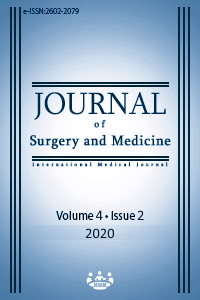Sleep quality & prevalence of restless legs syndrome among healthcare professionals
Keywords:
Healthcare professional, Sleep quality, Restless legs syndrome, Depression, Occupational stressAbstract
Aim: Healthcare professionals constitute a high-risk group for occupational stress as a consequence of difficult working conditions and therefore, they are prone to sleep disorders. The present study aimed to determine the prevalence of poor sleep quality and restless legs syndrome among healthcare professionals working daytime duty at a tertiary center, and to identify potential factors influencing sleep quality.
Methods: A total of 150 participants including physicians, nurses and other health professionals were included in this questionnaire-based cross-sectional study. All participants completed a self-administered questionnaire comprised of the Pittsburgh Sleep Quality Index (PSQI), Beck Depression Inventory (BDI) and Restless Legs Syndrome (RLS) Study Group Diagnostic Criteria, as well as demographic characteristics.
Results: Global PSQI score was 6.8 and the mean BDI score was 11.8. A PSQI score of >5, which indicates poor sleep quality, was noted in 69 participants (46%), while Restless legs syndrome was found in 31 (21%) and depression in 40 (26%) of the participants. Workplace violence, working at an intensive care unit, working in the operating room, and BDI scores were found to be factors that independently contributed to poor sleep quality. Furthermore, age, occupational experience, working at intensive care unit, work environment unrest and BDI scores were predictors of RLS.
Conclusions: In a substantial proportion of healthcare professionals, sleep quality is somewhat impaired and RLS and depressive symptoms are also frequent in this population. Work environment unrest, working conditions and intensity of depressive symptoms are determinants of sleep disorders in healthcare professionals. Healthcare professionals should be regularly screened for the presence of sleep disorders to recognize and treat the underlying causative conditions.
Downloads
References
Gulia KK, Kumar VM. Sleep disorders in the elderly:a growing challenge. Psychogeriatrics. 2018;18:155-65.
Winokur A, Kamath J. Sleep Disorders and Mental Health. Psychiatr Clin North Am. 2015;38:xiii-xiv.
Avidan AY. Sleep and fatigue countermeasures for the neurology resident and physician. Continuum (Minneap Minn). 2013; 19(1 Sleep Disorders):204-22.
Backhaus J, Junghanns K, Broocks A, et al. Test-retest reliability and validity of the Pittsburgh Sleep Quality Index in primary insomnia. J Psychosom Res. 2002;53:737–40.
Buysse DJ, Reynolds CF III, Monk TH, et al. The Pittsburgh sleep quality index: A new instrument for psychiatric practice and research. Psychiatry Res 1989;28(2):193–213.
Nichols DA, Allen RP, Grauke JH, et al. Restless legs syndrome symptoms in primary care: a prevalence study. Arch Intern Med. 2003;163:2323-9.
Huang C, Chen JH. Meta-Analysis of the Factor Structures of the Beck Depression Inventory-II. Assessment. 2015;22:459-72.
Demir G. Daytime sleepiness and related factors in nursing students. Nurse Educ Today. 2017;59:21-25.
Weaver MD, Vetter C, Rajaratnam SMW, et al. Sleep disorders, depression and anxiety are associated with adverse safety outcomes in healthcare workers: A prospective cohort study. J Sleep Res. 2018;27:e12722
Ghalichi L, Pournik O, Ghaffari M, Vingard E. Sleep qualıty among healthcare workers. Arch. Iran Med. 2013 Feb;16(2):100-3.
Yasin R, Muntham D, Chirakalwasan N. Uncovering the sleep disorders among young doctors. Sleep Breath. 2016;20:1137-44.
Beebe D, Chang JJ, Kress K, Mattfeldt-Beman M. Diet quality and sleep quality among day and night shift nurses. J Nurs Manag. 2017;25:549-57.
Tsai PC, Lin JH, Hsu HC. Fxploring sleep quality, spiritual health, and related factors in nurses in the intensive care unit. Hu Li Za Zhi. 2019 Aug;66(4):49-59
Han Y, Yuan Y, Zhang L, Fu Y. Sleep disorder status of nurses in general hospitals and its influencing factors. Psychiatr Danub. 2016;28:176-83.
Okoli CTC, Seng S, Otachi JK, Higgins JT, Lawrence J, Lykins A, et al. A cross-sectional examination of factors associated with compassion satisfaction and compassion fatigue across healthcare workers in an academic medical centre Int J Ment Health Nurs. 2019 Dec 6.
Ghalichi L, Pournik O, Ghaffari M, Vingard E. Arch Iran Med. Sleep quality among health care workers. 2013 Feb;16(2):100-3.
Tsai PC, Lin JH, Hsu HC. Exploring sleep quality, spiritual health, and related factors in nurses in the intensive care unit. Hu Li Za Zhi. 2019 Aug;66(4):49-59
Foster SN, Hansen SL, Capener DC, et al. Gender differences in sleep disorders in the US military. Sleep Health. 2017;3:336-341.
Smagula SF, Krafty RT, Taylor BJ, et al. Rest-activity rhythm and sleep characteristics associated with depression symptom severity in strained dementia caregivers. J Sleep Res. 2017; 26:718-25.
Zhang Y, Duffy JF, De Castillero ER. Do sleep disturbances mediate the association between work-family conflict and depressive symptoms among nurses? A cross-sectional study. J Psychiatr Ment Health Nurs. 2017;24:620-8.
Sun T, Gao L, Li F, et al. Workplace violence, psychological stress, sleep quality and subjective health in Chinese doctors: a large cross-sectional study. BMJ Open. 2017;7:e017182.
Civi S, Kutlu R, Tokgoz S. Frequency, severity and risk factors for restless legs syndrome in healthcare personnel. Neurosciences (Riyadh). 2012;17:230-5.
Elif Gökçal, Sibel Tamer, Özge Kiremitçi. Hastane çalışanlarında huzursuz bacak sendromu sıklığı ve yaşam, uyku kalitesi üzerine etkisi. Van Tıp Dergisi:2015;22(4):260-5.
Downloads
- 647 1130
Published
Issue
Section
How to Cite
License
Copyright (c) 2020 Ülkü Figen Demir
This work is licensed under a Creative Commons Attribution-NonCommercial-NoDerivatives 4.0 International License.
















